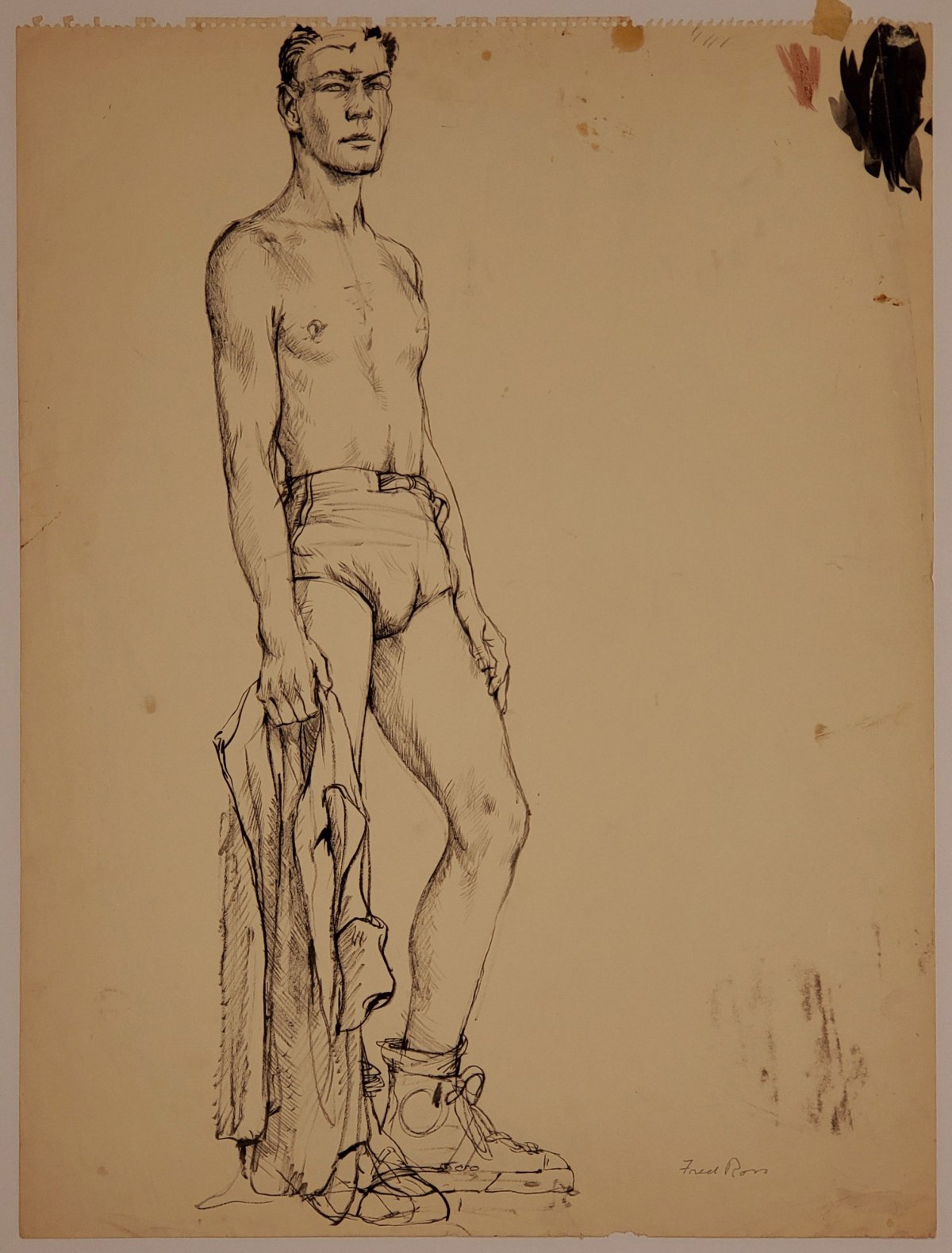FREDERICTON – Decked out in his trademark Stetson and plywood-pounding cowboy boots, it’s hard to imagine country-folk legend Stompin’ Tom Connors as a male model.

And yet, a recently acquired artist’s drawing from the 1950s – obtained by the Beaverbrook Art Gallery in Fredericton – offers a revealing glimpse of the troubadour as a lanky, squared-jawed teen wearing nothing but tight athletic shorts and high-topped sneakers.
“It was an innocuous sketch,” John Leroux, the gallery’s manager of collections and exhibitions, said in an interview Wednesday.
“It wasn’t finished. It wasn’t coloured. But as soon as you link it with the origin story, it becomes this fantastic artifact with this really deep resonance …. This would have been just before he hit the road.”
The drawing was among a collection of artworks by New Brunswick artist Fred Ross, recently donated to the gallery.
“I got to choose,” said Leroux. “I was like a kid in a candy store…. (Ross) was a noted figurative painter in the ’40s, ’50s and ’60s.” The museum is currently closed because of the COVID-19 pandemic, but Leroux says the sketch will be on public display after it reopens.
- Law (Taylor’s Version): 1st-ever Taylor Swift law course in Canada comes to Queen’s University
- Randy Bachman plans to auction off 200 of his guitars next month
- Taylor Swift surprises fans with double album, ‘The Tortured Poets Department’
- Hot Docs left out of budget 2024 funds as financial woes cloud arts organization
A student of Ross’s work, Leroux recognized the drawing as a preparatory sketch for a large mural that Ross would later paint inside the former Saint John Vocational School in the early 1950s, when Connors was a student there.
A tribute to higher learning, the mural outside the auditorium features images of three bare-chested young men – all of them based on Ross’s study of Connors.
“I double-checked with some photographs and, yes, this was Stompin’ Tom,” Leroux said, adding that Connors, who died in 2013, wrote about posing for Ross in his 1995 autobiography, “Before the Fame.” In his book, Connors noted that the painted figures’ faces “had all been mercifully modified to give each character a semblance of good looks.”
Born in Saint John, N.B., on Feb. 9, 1936 to an unwed teenage mother, Connors’ early life was marked by poverty. He recalled hitchhiking with his mother and begging on the streets before he was placed in the care of Children’s Aid at the age of eight. He was adopted a year later by a family in Skinner’s Pond, P.E.I., but ran away four years later.
While there are plenty of stories about how Connors then hitchhiked across the country, that didn’t happen until after he spent two years at the vocational school in Saint John. He posed for the mural when he was about 15 or 16 years old, Leroux said.
The mural that features Connors’ chiselled figure is juxtaposed with another mural that depicts the rough lives of those living in Saint John’s slums. The paintings were the subject of Leroux’s 2002 thesis for his master’s degree from Concordia University in Montreal.

Leroux says the murals resonate with Connors’ larger-than-life mission to tell enduring stories about one of the world’s largest countries.
“It fits with Tom,” he says. “He was about storytelling, giving a message …. These paintings are meant to have a narrative, too.”
And the flattering depictions of Stompin’ Tom’s younger self also speak to his confidence and will to succeed, Leroux said. “You had to be confident to wear those tight 1950s gym shorts.”
Legend has it that after Connors left the school, he wandered from town to town, at times working on fishing boats, as a grave digger, tobacco picker and fry cook.
As the story goes, he began his musical career when he found himself short of cash at the Maple Leaf Hotel in Timmins, Ont., in 1964 at age 28. In exchange for a beer, Connors played a few songs, then signed on for a 14-month contract to play at the hotel. Three years later, Connors made his first album, which included his first hit in 1970 with “Bud The Spud.”
His distinctly Canadian ditties, including “The Hockey Song,” “Sudbury Saturday Night,” and “Canada Day, Up Canada Way,” earned him a loyal following across the country.
“I’m a man of the land, I go out into the country and I talk to people and I know the jobs they do and how they feel about their jobs,” Connors once said.
“And I’ve been doing that all my life, so I know Canada like the palm of my hand. I don’t need a map to go anywhere in Canada. I know it all.”
– By Michael MacDonald in Halifax.
This report by The Canadian Press was first published Feb. 10, 2021.





Comments